Depth
According to insiders, OpenAI founder Sam Altman is seeking $100 million in new funding for Worldcoin, another cryptocurrency project he founded, and is currently in advanced negotiations. “Financial Times” quoted an insider as saying that the new round of financing has received support from existing and new investors. As early as 2022, Worldcoin received investments from institutions such as Andreessen Horowitz (a16z) and Khosla Ventures with a valuation of up to $3 billion, which means that the valuation of the project has tripled in just one year. It is reported that in October 2021, Worldcoin completed a $25 million Series A financing led by a16z, with a valuation of $1 billion. Other investors include Digital Currency Group, Coinbase Ventures, Multicoin, as well as angel investors such as FTX founder Sam Bankman-Fried and LinkedIn co-founder Reid Hoffman.
Financing in the crypto winter is not an easy task, and it is even harder to get such a huge amount. Why did Worldcoin, which was unheard of before, receive capital attention two years later and still be able to obtain huge investment with a valuation of $3 billion in the crypto winter? What investment potential do investors see in Worldcoin? What does Worldcoin mean for the wallet track and the crypto industry?

- Review of encryption index products: Phuture, Index, Alongside
- Ledger delays launching its key recovery service “Ledger Recover”
- The Power of Staking Assets: The Rise of Ethereum Staking and LSDfi
Introduction to Worldcoin
Worldcoin was proposed by Altman in 2019, inspired by the economist’s theory of “universal basic income (UBI)”, hoping to achieve fair distribution of wealth by sending free cryptocurrency Worldcoin, which can be simply understood as re-distributing the wealth created in the AI era through the “money-giving” method of universal basic income (UBI).
Since it is free money, a method is needed to determine the identity of the user and prevent the same person from receiving tokens multiple times with different identities. Therefore, World ID was developed as the underlying identity protocol of Worldcoin, which can ensure that each person can only register one account with their iris.
In addition, the team has also developed a set of biometric devices to verify a person’s uniqueness by scanning the iris, and to ensure the privacy of the verified person through zero-knowledge proof. This scanner, called Orb, is currently in beta testing. It uses an open-source design and has two lenses, wide-angle and telephoto, which work together with neural networks to capture high-definition images of the iris. Due to compliance restrictions, the device is currently only available for trial in some regions, including Argentina, Chile, India, Kenya, Portugal, and Spain.
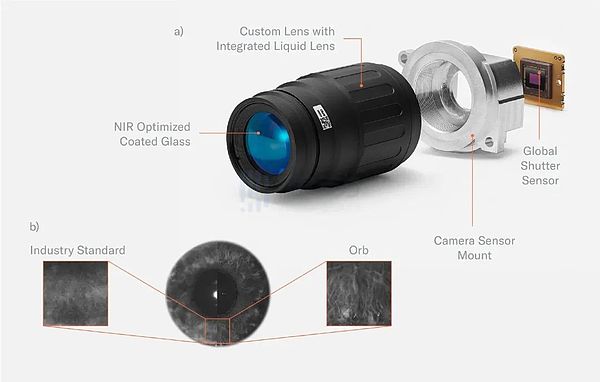
Orb’s function is very simple: scan human iris and convert the biological feature image into an unbreakable hash code consisting of letters and numbers. Worldcoin calls it “IrisCode”. If it is verified as a new registered user by comparing it with the data in the database, a new WorldID will be added to the Worldcoin database, and an encrypted wallet with a QR code will be generated. Through this wallet, users can get free Worldcoin tokens.
In summary, Worldcoin is a product ecosystem built around UBI, which includes 3 products in total: a WLD Token that will be distributed for free to 1 billion people worldwide, a verification protocol called World ID to determine the real identity, and a wallet called World App to store tokens.
From the narrative of grand vision to the initial product form and user data
Worldcoin, which originated from the UBI theory, has a very grand ideal since its inception-to distribute digital currency for free to 7.9 billion people worldwide and achieve fair distribution of wealth.
“Through UBI, billions of people around the world can get rid of poverty, and achieve the goal that Bitcoin cannot achieve because it is too expensive and the transaction speed is too slow-the expansion of the cryptocurrency and its financial system to hundreds of millions of people.” This is a bold plan and also a utopian vision. Although the vision is beautiful, it is also easy to become a pure narrative talk. With a small user base of cryptocurrency users, Worldcoin’s ambition was once questioned to be comparable to the “moon landing plan”.
However, with two years of silent development, Worldcoin has taken shape in terms of product form and user growth, and its business logic has become clearer beyond the ideal narrative logic.
First of all, sending Free coins to users worldwide is not only a narrative skill, but also a very clever user acquisition strategy. Every time a new account receives cryptocurrency, it brings a new wallet user to Worldcoin, which will help Worldcoin seize the wallet entrance. In the encryption industry, mastering the wallet is equivalent to seizing the traffic entrance.
Data shows that the ecological wallet “World App” launched a few days ago has already conducted small-scale testing. The number of registered users is close to 1.7 million, and it is rapidly increasing at a rate of one new user every 14 seconds, making it the fastest growing wallet in the world. Users have completed website, mobile application, and encrypted DApp login authentication more than 6.3 million times through World ID, and the total number of sending and receiving transactions has exceeded 690,000, with a daily transaction volume of 60,000.
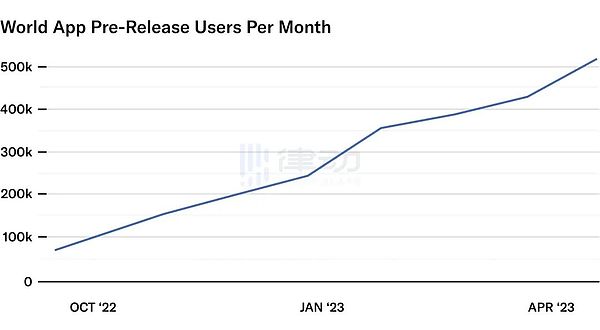
At first glance, 1.7 million is not a dazzling figure, but for the cryptocurrency industry, it is still a considerable figure.
The breakout of Worldcoin is not groundless. At least from the product design of the recently released “World App” and the economic model of Worldcoin, we can see some traceable fundamentals.
In terms of product design, the team “accurately positions target users and optimizes product usability.”
Due to the objective compliance problems faced by Worldcoin, most of the countries currently open are in third world countries and regions. This means that from the beginning, Worldcoin has taken the route of surrounding cities with rural areas, which also conforms to Worldcoin’s main goal-universal finance. Of course, universal finance should prioritize coverage in underdeveloped countries with weak financial infrastructure, which is the vast majority of the people in the vast areas of Asia, Africa, and Latin America that Worldcoin currently covers.
Since it is the route of universal finance, the residents of those regions and countries where the financial infrastructure and hardware equipment are generally lacking should be the first to consider.
In response to the current situation where most of the third world’s financial infrastructure and hardware equipment are not yet perfect, Worldcoin has made the greatest inclusive and friendly improvement to the product design. On May 8, Worldcoin announced the launch of the ecological wallet “World App”. This exclusive wallet supports transactions without gas fees, is compatible with OS and Android versions, and currently supports downloads in more than 80 countries/regions around the world, supporting multiple local languages. The product size is only 18MB, and it can even support phones with a service life of 10 years.
At the product level, the team designs the product based on the lowest software and hardware standards to reduce the usage threshold of current users to the lowest level. Only in this way can the original vision-including most of the people in the world-be included and reach people in various parts of the world, including those who cannot access the new digital economy.
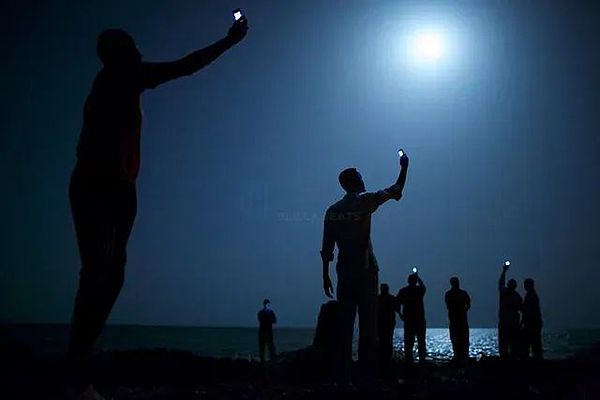
Figure: “National Geographic”/John Stanmeyer photographed African immigrants holding mobile phones to receive cheap signals from Somalia to contact overseas relatives on the evening of February 26, 2013, on the coast of Djibouti.
Regarding token mechanism, Worldcoin uses a deflationary reward model and incentivizes activity through completing tasks.
According to the plan, Worldcoin is expected to issue WLD tokens before the end of June, with a total supply of 10 billion. Over 80% of the token supply will be distributed to the community and contributors through free distribution.
To incentivize early contributors, rewards are based on a deflationary mechanism, which means that the amount received by later contributors will decrease as more people join. This not only motivates early participation and increases user growth rates, but also creates FOMO effects, particularly for crypto old-timers who cannot participate in certain regions due to compliance requirements, generating buying pressure in the market and creating momentum for price discovery.
In addition, WLD tokens are not distributed all at once, but are obtained by completing tasks. In the early stages, one token is distributed per week, with the time interval for obtaining tokens increasing over time, possibly to one token per month. This helps to maintain user activity. From the data, it has also achieved good results, with a total user count of 1.7 million and a daily transaction volume of 60,000.
World ID: The Antidote to the Pervasive Spread of False Content in the AI Era
With the widespread use of artificial intelligence, the proliferation of false and anonymous accounts on the Internet will intensify. Artificial intelligence is good at imitating human behavior by generating text, deep fakes, or bypassing common verification methods, making it increasingly difficult to distinguish between human and robot/false accounts, and identity verification becomes an urgent problem.
As an open and permissionless identity protocol, World ID can not only serve as a globally applicable digital passport, but can also anonymously prove a person’s uniqueness, that is, “you are you” without revealing privacy.
World ID uses proof of personhood to address two problems caused by AI: preventing witch attacks and minimizing the spread of misinformation generated by AI.
Since we recognize that AI will bring about industrial revolution-level changes to human society, solutions to the problems it creates will also be a real need.
If the so-called inclusive finance and UBI in the early stage of entrepreneurship still remain a certain idealistic narrative logic, Worldcoin, two years later, not only has a real product and real user growth, but also shows us its reasonable business logic. Moreover, it stands at a higher level and has a real demand at the level of social significance.
It can be said that besides its reasonable business logic, Worldcoin can also solve real social problems at a higher level. This is why Worldcoin, which was still unknown two years ago, is favored by top capital today and still obtains huge investments at a high valuation in the cold winter.
Interestingly, Sam Altman, the founder of Worldcoin, is also the founder of OpenAI. OpenAI has played an important role in leading a new round of hot spots in the AI field. It can be said that the success of OpenAI and ChatGPT has given Worldcoin a new opportunity. This not only means that Sam Altman’s personal halo enables investors to “dig out” his other project, Worldcoin, but also, at another level, the potential threat of large-scale creation and dissemination of inaccurate information led by artificial intelligence can be solved by the latter, which provides a real usage scenario and use case for its business logic. To some extent, these two projects have achieved a perfect self-consistent closed loop.
What does it mean for the cryptocurrency industry?
The “World App”, which currently gains a new user every 14 seconds, is the fastest growing wallet in the world. Considering the logic that “mastering the wallet means mastering the traffic entrance of the cryptocurrency industry”, the importance of Worldcoin for the wallet track is beyond doubt. Considering that transaction fees may be introduced in the future (according to Tiago Sada, the product, engineering and design director of Tools For Humanity, World App charges a few basis points per transaction), mastering the traffic entrance of the wallet will bring huge business success to World App.
If Worldcoin can continue to expand steadily and achieve its target expectations, it may bring tens of millions of incremental users, which may intensify the pace of large-scale adoption of cryptocurrencies, which is good news for the whole industry and the most important value for the entire cryptocurrency industry.
Under the current restrictions of compliance issues, Worldcoin is forced to prioritize opening up to underdeveloped third-world regions and countries. For people in these areas lacking financial infrastructure, when they scan their eyes and complete a series of follow-up operations, they are likely to have their first wallet, and WLD will be their first cryptocurrency in life.
Therefore, for every new user who receives WLD tokens, it is equivalent to converting one more user of the “World App” wallet. This not only allows WorldCoin to successfully occupy a key entry point in the cryptocurrency industry – wallets, but also brings incremental users to the cryptocurrency industry. Because every new World ID has the potential to flow from the WorldCoin ecosystem into other corners of the cryptocurrency world, this will benefit the entire cryptocurrency industry.
The Worldcoin ecosystem wallet, World App, which carries new users, will use its vast cryptocurrency channels to transport these new cryptocurrency novices to other cryptocurrency ecosystems.
In fact, from the very beginning, WorldCoin, which emphasizes openness and equality, has had a close connection with the cryptocurrency industry. This is not only reflected in the founding team and VC background, the cryptocurrency-native project genes, but also in ecosystem development, integration, and extension, the WorldCoin team actively connects and cooperates with various cryptocurrency ecosystems.
Let’s see where WorldCoin’s tentacles have reached:
WorldCoin’s native token WLD will be issued on Ethereum, the underlying protocol of World ID has run on Polygon, and it is planned to be migrated to Optimism OP mainnet with World App. In addition, WorldCoin is actively developing and building around cross-chain.
World App, the native wallet built for WorldCoin, not only supports the payment, purchase, and transfer of Beta WLD, but also supports the corresponding functions of many other tokens, including WETH, WBTC, DAI, USDC (more tokens will be supported in the future);
World App also supports CEX and decentralized applications, currently supporting applications including Uniswap, ENS, Circle, Safe, MoonBlockingy, RampNetwork.
The WorldCoin team once tested, implemented and released the EIP-4844 proposal together with the Optimism, Coinbase, and Prysm development teams. The goal of the proposal is to reduce L2 fees by 10 times, so that more users can afford to use DApps.
It can be said that WorldCoin is not only the wallet entrance, but also the entrance from the real world to the cryptocurrency industry. Entering the world of WorldCoin is equivalent to entering the cryptocurrency ecosystem such as Ethereum and Bitcoin.
Imagine such a scene, World App continuously delivers fresh blood to the cryptocurrency world through WorldCoin. These new users who have their own wallet and digital identity for the first time will have their first experience of using cryptocurrency to purchase and trade. They will also start to try more different cryptocurrency operations. In addition to passively receiving airdropped WLD tokens, they will also use Ethereum, stablecoins to carry out more on-chain operations, including trading, financial management, and even publishing and collecting NFTs.
What follows is a series of cross-chain, bridging, and application technology constructions surrounding the creation of World App, which is like a highway laid out around this wallet, connecting to Ethereum, Layer 2 Chains, decentralized applications, and platforms to expand new user scenarios. As a gateway to the real world of encryption, World App will connect other blockchains and ecosystems such as Ethereum, bringing new users to the industry and leveraging cryptocurrencies.
Of course, there has been no shortage of criticism of WorldCoin’s development, with critics mainly focusing on privacy and security, unrealistic goals, and exploitation of vulnerable groups.
Question 1: Can iris scans really guarantee the user’s true identity?
Although the team claims that the personality certification scheme combining the identity protocol World ID and the biometric device Orb can perfectly solve the problem of false accounts, can iris scans really guarantee the user’s true identity?
According to a tweet released by Blockbeats, due to compliance issues, WorldCoin has not yet opened in mainland China, resulting in users being unable to register. Therefore, a business of proxying iris scans has quietly appeared on the market, and an iris verification can be purchased for up to $30, and then a $20 reward can be claimed. According to these intermediaries, most of the human iris proxies come from rural Africa and Cambodia. The low cost of the proxy makes us wonder how much water the so-called 1.7 million users have?
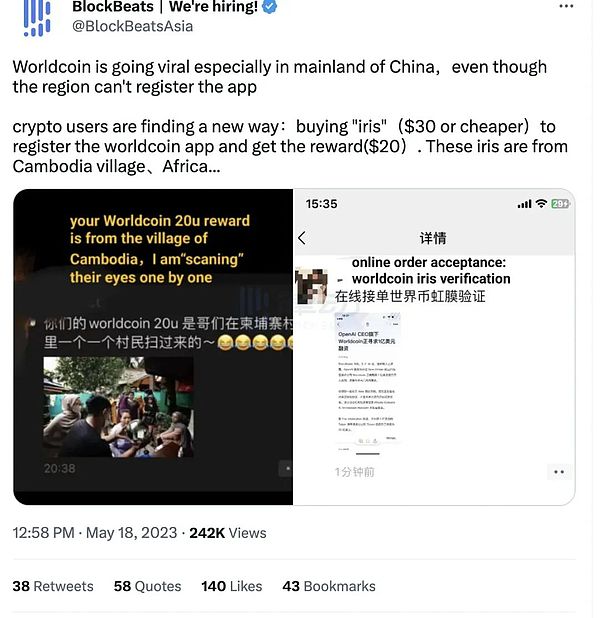
The Worldcoin team acknowledged the existence of the black market but emphasized that there were only a few hundred such cases. In response to the iris black market, Worldcoin has introduced new measures to crack down on the black market, including adjusting the first face-to-face registration process and implementing dynamic and static QR codes.
Question 2: Privacy and Security
A common criticism of Worldcoin is that the human iris scan may pose privacy and security issues.
Regarding this, the team’s explanation is that Worldcoin’s “underlying identity protocol” World ID uses zero-knowledge proof technology to verify the user’s identity without sacrificing user privacy, protecting the privacy of user iris data. Unlike typical biometric identification methods in digital identity systems, iris scanning is only used for identity verification, and the iris image itself is not kept (unless the user selects this option). The iris hash value (IrisHash) generated by Orb after processing is passed into the database, which is generated locally and is one-way and irreversible.
However, today we have higher requirements for transparency of data privacy, such as where data is stored, whether there is a possibility of sharing data with third parties, and if so, with whom.
Question Three: former Ethereum Foundation member criticizes WorldCoin’s economic model and regional issues
Former Ethereum Foundation member Hudson Jameson tweeted questioning WorldCoin’s claim to create a fair global currency and questioning WorldCoin’s economic model, saying “WorldCoin’s token economic model is problematic. WorldCoin aims to empower people around the world to use the same currency, but only 80% of the tokens are distributed to users, 10% are reserved by the team, and the remaining 10% are given to investors.”
In addition, Hudson believes that WorldCoin’s distribution may bring huge socio-economic problems to the local area, and these problems are different in each region, but so far there is no publicly available information showing that the team has any solutions to these problems, nor has it formed a working group composed of relevant experts.
Therefore, Hudson believes that WorldCoin is unrealistic and even questions whether it can bring tens of millions of new users by 2025.
Question Four: Snowden has questioned WorldCoin, and MIT Technology Review calls it “crypto-colonialism”
As early as October 2021, Snowden questioned Worldcoin’s ID plan, fearing that Worldcoin would build a global iris database.
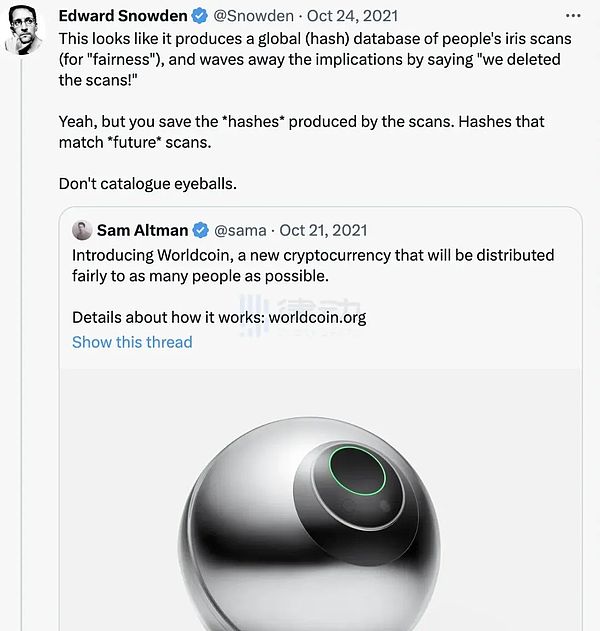
Snowden stated that this seems to be a global iris scan (hash) database generated under the pretext of “fairness”, and eliminates the impact by saying “We deleted these scans!” Snowden also warned, “Don’t use biometric technology for anti-fraud. In fact, don’t use biometric technology for anything.”
Recently, the American technology magazine MIT Technology Review also pointed out that Worldcoin is being tested first in low-income communities, which can be considered a form of crypto-colonialism because residents in these areas lack legal protection and data collection costs are lower and more convenient. According to technologyreview, as of March this year, Worldcoin’s iris scanning has been opened to 24 countries/regions around the world, including 14 developing countries and 8 in Africa.
Worldcoin may not be the perfect product, and in the short term it faces many problems, challenges and even crises. However, undoubtedly, it is currently the most potentially disruptive cryptocurrency application. If Worldcoin can succeed, its tokens will appreciate, which is why, apart from founder Altman, Worldcoin has attracted top Silicon Valley venture capital.
Like what you're reading? Subscribe to our top stories.
We will continue to update Gambling Chain; if you have any questions or suggestions, please contact us!